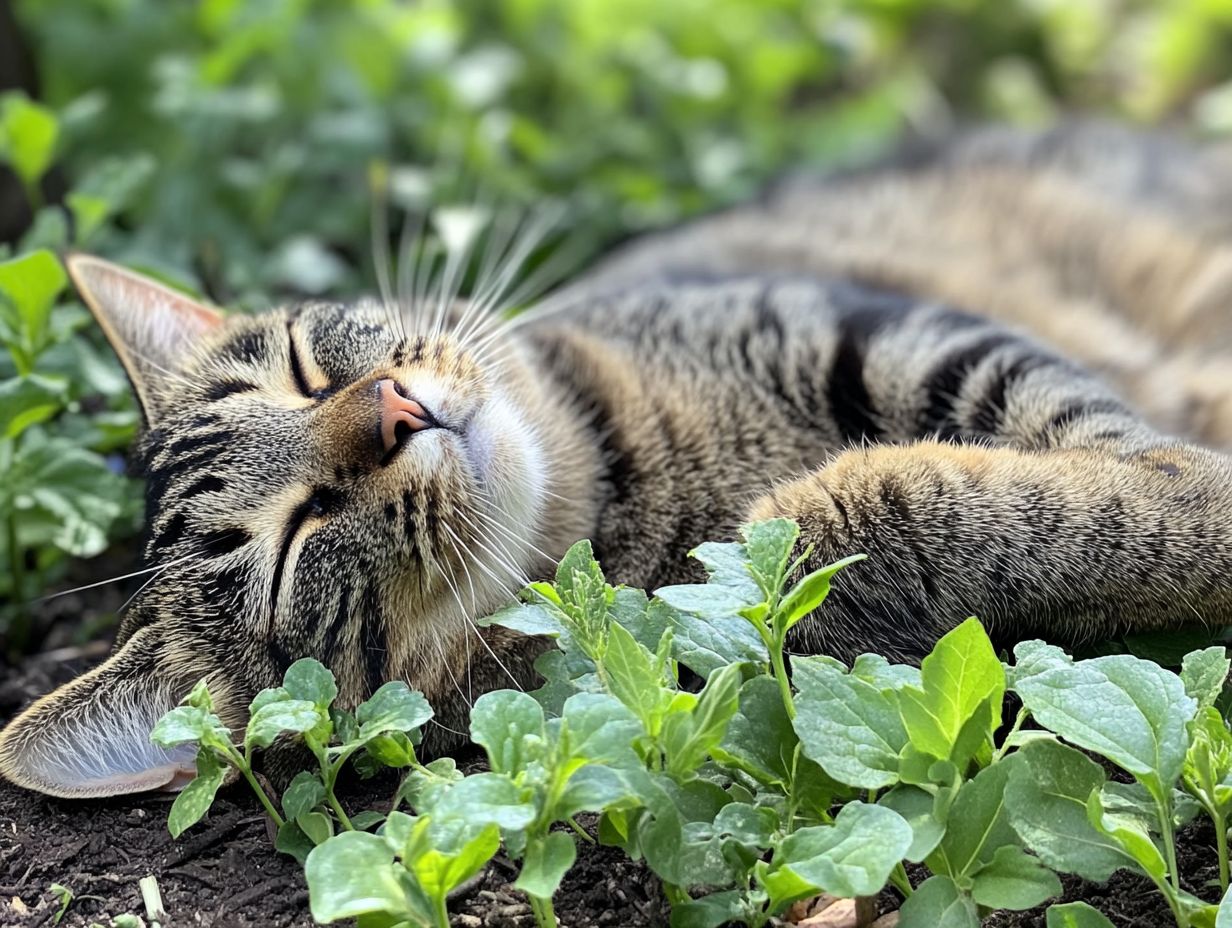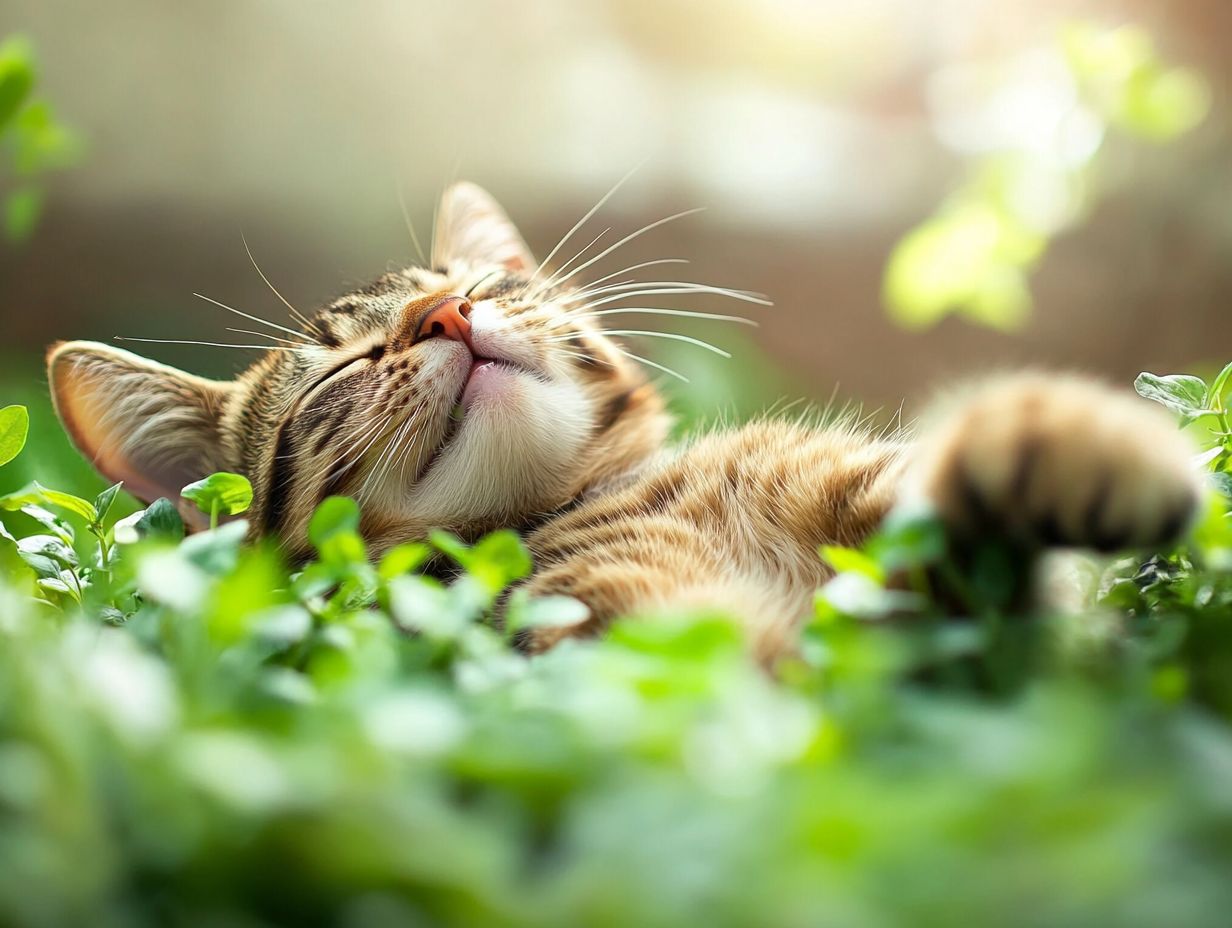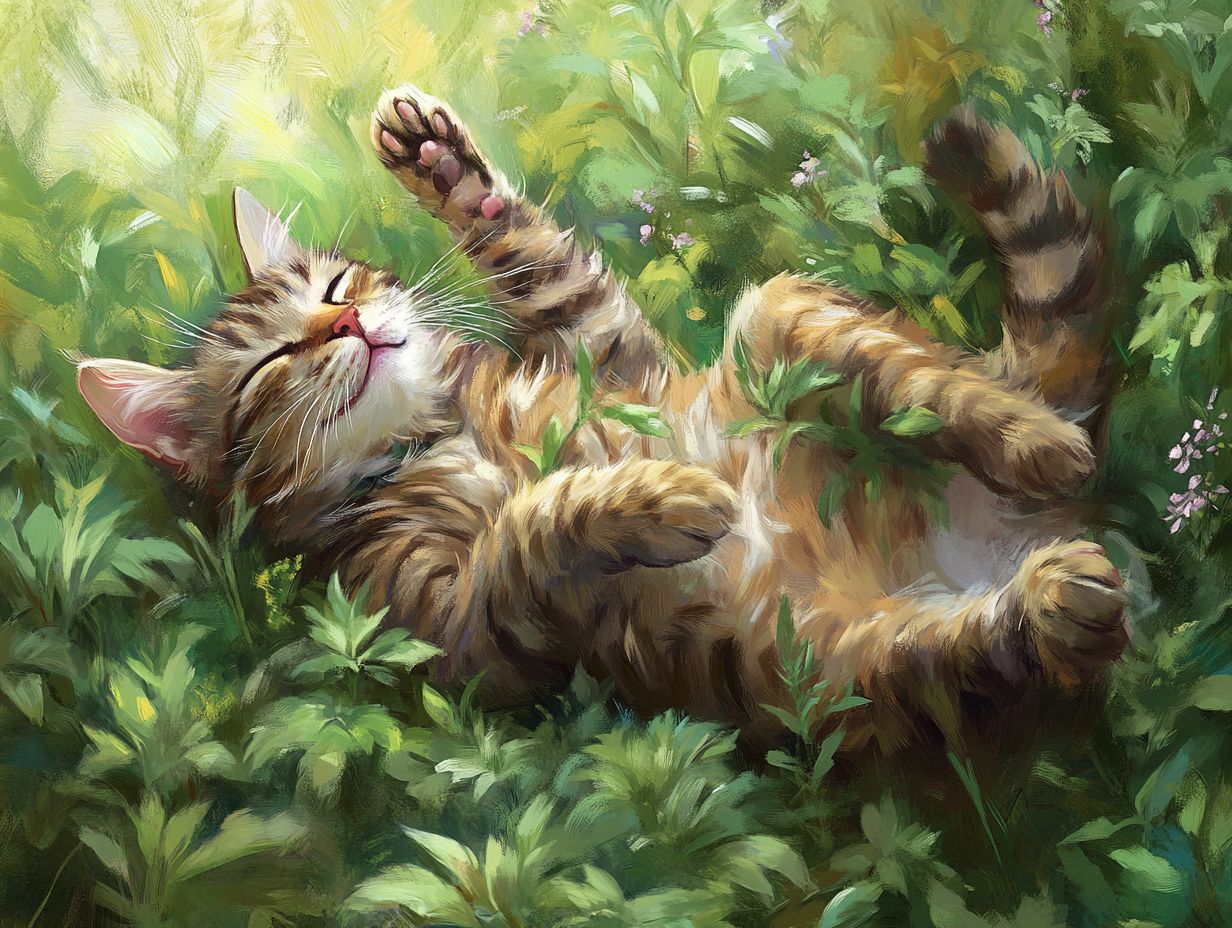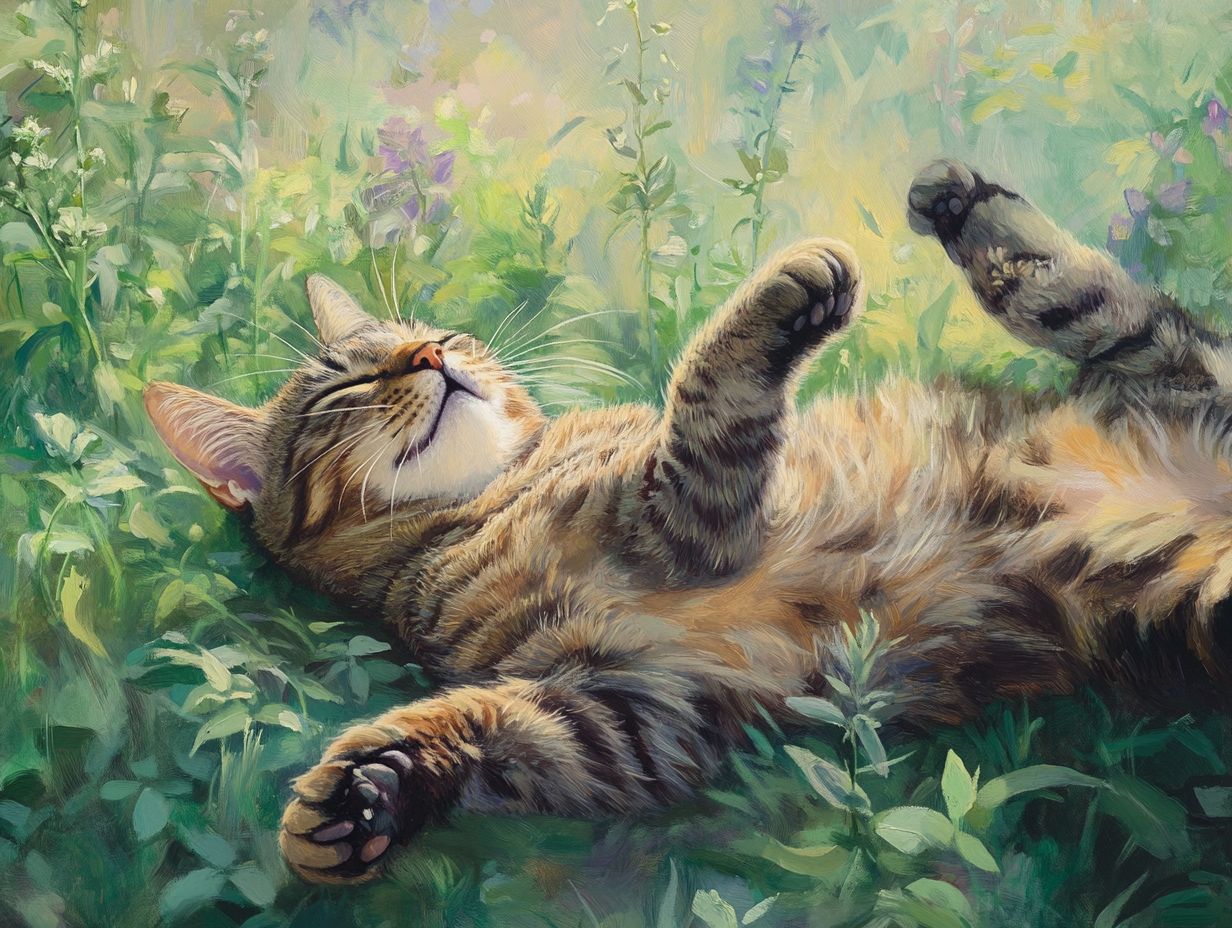Catnip, a beloved herb among feline enthusiasts, is more than just a playful plant; it represents a vital component in understanding cat behavior. Recent studies published in journals like the Journal of Veterinary Behavior highlight its significant effects on feline interactions.
This text explores its definition and intriguing history, revealing how it has captivated cats and humans alike for centuries.
It delves into the effects catnip has on our furry friends and even on us, unpacking its chemical makeup and uncovering the science behind its enchanting appeal. Cats may experience a heightened sense of excitement when interacting with catnip.
Discover the various uses of catnip, including fresh catnip and catnip toys, any potential side effects, and practical tips on how to incorporate it into your life. Consider how environmental factors, such as the presence of other pets and available space for play, can influence a cat’s response to catnip.
Join in on this journey to unlock the secrets of catnip!
Key Takeaways:

What is Catnip?
Catnip, scientifically known as Nepeta cataria, is a perennial herb from the mint family that is highly favored among cat owners due to its effects on feline behavior.
This natural herb stimulates playfulness in cats by activating olfactory cells that send signals to the brain, inducing a euphoric response. This response is often characterized by playful behavior, including rolling and climbing.
The active compound nepetalactone elicits an intriguing genetic response in many cats, making catnip a popular choice for encouraging play and enhancing overall feline health. This stimulating herb connects directly with olfactory cells, amplifying the feline response.
1. Definition of Catnip
Catnip, scientifically known as Nepeta cataria, is an herb from the mint family renowned for its stimulating effects on cats. Biologically classified within the Lamiaceae family, catnip contains an active compound called nepetalactone, which induces a euphoric response in many felines.
This reaction can manifest as rolling, purring, and other playful behaviors, typically lasting for a few minutes. Many cat owners utilize various forms of catnip, including dried leaves (which can be sprinkled in play areas), infused toys, and sprays, all aimed at enhancing their cat’s environment.
2. History of Catnip
The history of catnip reveals that it was first utilized in ancient cultures, where it was recognized for its effects on feline behavior and often regarded as a magical herb. This was especially true in ancient Egyptian culture, which viewed catnip as a special plant associated with playful behaviors in cats.
While modern scientific studies have documented its significant effects on the genetic responses of various cat breeds, the history of the catnip plant demonstrates its enduring presence in the hearts and homes of many ancient civilizations. The Greeks employed it as a calming agent for both cats and humans, while medieval herbalists noted its use for a range of ailments affecting both humans and animals. For more information, check out What is Catnip? | What Does Catnip Do?.
As society evolved, so did the perceptions of this herb, transforming from a wild botanical curiosity to a staple in modern cat care. Today, pet owners recognize that catnip is an excellent way to enhance a cat’s environment by stimulating its natural instincts to play and explore.
Understanding its herbal history underscores its long-standing significance and reaffirms its current role in improving cat behavior in contemporary households.
What Does Catnip Do?
Catnip has a variety of effects on cats, primarily due to its active compound, nepetalactone. This compound has been shown to induce behavioral changes, including increased playfulness, enhanced relaxation, and an overall euphoric reaction.
As a result, this stimulating herb is a favorite among many cat owners, who incorporate it into various products to enrich playtime and provide engaging experiences for their pets.
1. Effects on Cats
Catnip has notable effects on cats, often leading to drastic behavioral changes characterized by a significant increase in playfulness and a euphoric reaction that can last anywhere from several minutes to a few hours. However, responses to catnip may vary across different life stages, including kittens, adults, and seniors, which can influence play behavior.
In multi-cat households, it’s essential to introduce catnip gradually to prevent conflicts and encourage shared play. Monitoring body language can provide insights into a cat’s enjoyment or disinterest in catnip, with signs of playfulness such as purring or rolling versus lethargy.
While catnip can enhance positive behaviors, overexposure may lead to overstimulation, aggression, or anxiety, so moderation is key. It’s also important to rule out medical issues before attributing behavioral changes solely to catnip use.
Incorporating catnip into a cat’s routine can strengthen the bond between cats and their owners. Using it in conjunction with reward-based training can enhance positive behaviors.
For more practical applications, consider creating play stations with catnip-infused toys and setting specific times for play sessions. Always source catnip sustainably to ensure its ecological impact is minimal. If a cat exhibits extreme reactions to catnip, it may be necessary to consult a veterinarian or animal behaviorist for guidance.
As you delve deeper into the wonders of catnip, remember that ongoing learning about feline behavior can significantly improve the life of your pet.
For instance, when exposed to this aromatic herb, cats frequently engage in energetic behaviors such as rolling on the floor, rubbing their faces against the source of the scent, and playfully pawing at it. This excitement often culminates in joyful displays of purring as they become over-stimulated and carefree. Studies show that these behaviors can significantly enhance a cat’s emotional well-being and provide environmental enrichment.
Many cat owners enjoy sprinkling dried catnip in their pets’ toys or sewing pillows filled with catnip to encourage playful interaction. The effects of catnip can vary, typically resulting in bouts of joy that last 10 to 30 minutes before tapering off, allowing cats to return to their baseline behavior and creating a delightful balance of calmness and playful antics. However, it’s essential to observe each cat’s response, as individual variations exist due to genetic factors and past experiences.
2. Effects on Humans
While catnip is primarily recognized for its effects on cats, it also offers several benefits for humans, including potential calming properties and applications in herbal remedies. Catnip has been utilized in herbal medicine for centuries to address anxiety and insomnia. For more information, you can read about what catnip does.
Many people enjoy brewing teas by steeping catnip leaves, which are believed to have mild sedative effects, making them ideal to drink before bed after a long day. The soothing aroma and flavor may also aid digestion and help relieve gastrointestinal discomfort.
Herbalists often recommend catnip for uplifting mood and alleviating headaches, among other benefits. It’s essential to consult with a healthcare professional for personalized advice on medicinal uses.
How Does Catnip Work?

Catnip contains an active compound known as nepetalactone. When cats inhale catnip, nepetalactone travels through their nasal mucosa and interacts with olfactory cells that connect directly to the brain. This interaction stimulates various neurological responses, including the release of endorphins, which is responsible for the euphoric reaction observed in most cats.
1. Chemical Composition of Catnip
The primary chemical compound in catnip is nepetalactone, a volatile oil that produces the plant’s unique effects on cats. This intriguing compound features a bicyclic structure with a lactone ring, which is essential for its interaction with feline olfactory receptors.
When a cat encounters nepetalactone, it binds to specific receptors in the nasal tissue, activating pathways that lead to euphoric behaviors such as rolling, rubbing, and purring. This reaction exemplifies the fascinating interplay between chemistry and biology, demonstrating how a single molecular structure can significantly influence behavior in a species. Moreover, specific breeds, such as Siameses and Abyssinians, are known for their heightened sensitivity to catnip, while others may show little to no reaction.
Interestingly, nepetalactone’s ability to elicit these responses varies among individual cats, underscoring the genetic factors that contribute to differing sensitivities. Catnip tolerance is a subject of ongoing catnip research.
2. How Catnip Affects the Brain
Catnip affects a cat’s brain by stimulating olfactory cells, which triggers a cascade of neurological responses, including the release of endorphins. This interaction excites the central nervous system, creating a euphoric state that many felines find irresistible.
The pheromones released during this stimulation can enhance the overall sensory experience, intensifying the animal’s response to their surroundings. Interestingly, not all cats are equally affected by catnip; approximately 50-75% of cats exhibit this sensitivity, with reactions ranging from playful exuberance to calm relaxation.
Variations in genetic predispositions play a significant role in these differences, making catnip a captivating subject for both behavioral studies and casual observation. Kittens, for instance, may not respond to catnip until they are about 3 to 6 months old, while older cats may display more subdued reactions.
What Are the Uses of Catnip?
Catnip serves multiple purposes beyond simply entertaining cats; it has medicinal, culinary, and household applications, showcasing its versatility as an herb, beloved among enthusiasts of herbs for cats. Cat owners can benefit from catnip in various ways, ranging from stimulating toys to soothing herbal remedies.
1. Medicinal Uses
Medicinally, catnip is celebrated for its calming effects and is commonly used in herbal treatments for stress and anxiety in both cats and humans. This gentle herb, belonging to the mint family, has been utilized for centuries due to its various medicinal properties. However, it’s crucial to monitor for signs of stress or overstimulation in cats, such as excessive meowing or hiding, and to adjust the environment accordingly.
To enhance the bond between owner and cat, positive reinforcement techniques can be beneficial. Rewarding a cat with play or interaction when they engage with catnip can encourage desired behaviors and strengthen the relationship.
2. DIY Catnip Activities
There are many safe and stimulating activity ideas involving catnip, such as creating DIY catnip toys or using it in puzzle feeders to promote environmental enrichment. These activities not only entertain cats but also engage their natural instincts.
Myth-Busting Catnip
Many misconceptions surround catnip usage, such as the belief that all cats are equally affected or that it can be harmful. In reality, around 50-75% of cats respond to catnip, and it is generally safe when used appropriately.
Care and Caution
When introducing catnip, be mindful of potential problem behaviors. Some cats may not respond positively to catnip due to overstimulation. Signs of stress might include hiding, aggression, or refusal to engage. If such behaviors arise, it’s advisable to reduce exposure and consult a veterinarian if necessary.
Multi-Cat Households
When using catnip in multi-cat households, it’s essential to manage resources to prevent conflict. Gradual introductions and monitoring interactions can help ensure a positive environment for all cats involved.
Seeking Professional Help
If unusual behaviors persist, it is appropriate to seek professional help regarding catnip exposure and its effects. A veterinarian or animal behaviorist can provide tailored advice based on individual circumstances.
Conclusion
Catnip serves as a bridge for enhancing the human-cat bond through shared experiences. Its role in stimulating play and relaxation can enrich both cats’ lives and their owners’ experiences.
For ongoing learning, consider exploring additional resources, such as books or reputable websites focused on cat health and behavior. Ethical considerations regarding sourcing catnip and its environmental impacts should also be acknowledged, encouraging responsible usage.
In humans, catnip can promote relaxation, making it beneficial for those seeking relief from insomnia or looking to improve their sleep patterns. Its antispasmodic properties can alleviate gastrointestinal distress, helping to ease symptoms of indigestion and menstrual cramps. According to a study published in the Journal of Ethnopharmacology, catnip has been shown to have mild sedative effects.
Additionally, some studies suggest that catnip may possess mild analgesic properties, which can be helpful for treating minor aches and pains. For felines, catnip provides joy and stimulation, encouraging playful behaviors while also helping to reduce hyperactivity. It’s important to note that not all cats react the same way to catnip; individual genetic factors play a significant role in their response.
2. Culinary Uses
In culinary contexts, Nepeta cataria, commonly known as catnip, can be used to create soothing herbal teas and enhance various recipes with its unique flavor profile. This aromatic herb, renowned for its calming properties, beautifully complements a variety of dishes, enriching both taste and wellness.
One delightful way to enjoy catnip is by brewing a warm tea that combines its leaves with honey and lemon for an invigorating beverage. Culinary enthusiasts can also experiment by incorporating dried catnip into soups, stews, or herb-infused oils to impart a mild minty flavor. However, consumption should be moderated to avoid mild gastrointestinal disturbances.
Pairing catnip with fresh vegetables or adding it to salad dressings can elevate the dining experience, making it a versatile addition to any culinary repertoire. Beyond enhancing flavor, the herb offers a range of health benefits, promoting relaxation and aiding digestion.
3. Household Uses
Household uses of catnip include products like catnip spray and toys that stimulate a cat’s natural instincts and behaviors. Cat owners can explore a variety of enjoyable catnip products designed to enhance kitty’s playtime and provide stimulating herb benefits for their feline companions.
For instance, catnip pillows and toys that produce crinkly sounds encourage playful behavior, while scratching posts infused with catnip help keep claws trimmed and provide entertainment. Understanding your cat’s body language can help you realize when they are engaged and enjoying the stimulus of catnip.
Additionally, there are catnip bubbles for outdoor play and interactive feeders that promote mental activity, allowing cats to engage in their natural hunting behaviors.
Are There Any Side Effects of Catnip?

Catnip is generally safe for most cats; however, excessive consumption can lead to side effects such as overstimulation and altered behavior, known as catnip overdose. It is important for all cat owners to understand the appropriate limits for catnip usage to prevent behavioral changes and ensure catnip safety. Signs of overstimulation include excessive meowing, restless behavior, and temporary disorientation.
1. Side Effects on Cats
Cats that are excessively exposed to catnip may experience side effects such as overstimulation, lethargy, or even temporary disorientation, known as catnip overdose. These side effects typically occur shortly after a cat is exposed to the herb, particularly if they have not been introduced to it in a controlled manner. It is advisable for owners to limit catnip exposure to sessions of about 10-15 minutes, allowing their pet time to recuperate.
To ensure safer use, owners should be aware of individual variations in their cats’ reactions to catnip based on breed or past experiences. By being aware of these behaviors, owners can better administer catnip and ensure it remains a pleasant experience rather than a troublesome one.
2. Side Effects on Humans
Side effects from catnip in humans are rare and typically limited to mild gastrointestinal disturbances when consumed in excess. Some individuals may experience drowsiness or headaches if they are particularly sensitive to herbal remedies. The plant’s pheromone mimic properties can affect olfactory cells, contributing to these sensations. For more information, check out What is Catnip? | What Does Catnip Do?.
Catnip should be used cautiously, especially for medicinal purposes, as its natural sedative effects may lead to unwanted additive effects when combined with certain medications. Pregnant or breastfeeding individuals should exercise caution as well, given the insufficient data regarding its safety in these populations.
As with all herbal treatments, catnip should not be used without the guidance of a qualified healthcare professional to avoid unintended side effects and interactions.
How to Use Catnip?
Using catnip can be a great way to enrich your cat’s life and strengthen the bond between you. Here are some tips:
- Consider creating a catnip garden where your cat can explore and enjoy a natural environment.
- Incorporate catnip-infused toys and products for positive reinforcement during playtime, satisfying their natural instincts.
- Observe your cat’s body language for signs of enjoyment, such as purring or relaxed posture.
- In multi-cat households, introduce catnip gradually to ensure that all cats have an opportunity to enjoy it without causing conflict.
- If signs of overstimulation appear, consult with a veterinarian regarding your cat’s reaction to catnip.
Catnip can enhance your cat’s playtime and relaxation in various ways, such as through catnip toys, dried catnip, and catnip treats, depending on your cat’s preferences. This stimulating herb is known for its relaxing effects, offering a euphoric reaction during playtime. Research has shown that nepetalactone, the active compound in catnip, triggers specific behavioral responses in cats (source: Journal of Ethnopharmacology).
Understanding how to use catnip effectively can improve your cat’s play experience and strengthen the bond between you and your feline friend. Catnip can affect a cat’s emotional state and well-being, enhancing their environment and social interactions.
1. For Cats
The most popular ways to use catnip for cats include catnip toys and treats, both of which stimulate play and enhance a cat’s well-being. The types of products selected can significantly influence a cat’s engagement and enjoyment. It’s important to note that individual responses to catnip can vary based on breed, genetics, and prior experiences, which explains why some cats may not respond at all.
When choosing catnip toys, consider factors such as texture, size, and shape; interactive toys that encourage batting, chasing, and pouncing are often the most engaging and promote exercise. Catnip treats serve as an excellent way to reward good behavior and inspire playful antics. Using catnip as a tool for positive reinforcement can also be beneficial during training sessions.
It is important to look for high-quality products that contain organic catnip to ensure that the stimulation is both safe and satisfying. A thoughtful combination of these elements can help create an enriched environment that supports a cat’s natural instincts, leading to greater joy and health. Additionally, incorporating catnip into various toys and puzzles can stimulate a cat’s natural instincts and keep them engaged.
2. For Humans
Humans can benefit from catnip through various herbal uses, including the preparation of calming catnip tea to harness the herb’s relaxing properties. This versatile herb can be steeped in hot water to create a flavorful infusion that provides a light, soothing sensation, potentially aiding in relaxation and reducing occasional anxiety.
Beyond teas, catnip is also utilized in various herbal remedies and may contribute to improved digestive health and better sleep patterns. Many people find that incorporating catnip into aromatherapy or using it as an ingredient in tinctures enhances its calming effects, helping them unwind after a busy day. These applications underscore the natural benefits that this unassuming herb can offer to people’s lives.
Where Can You Buy Catnip?
Catnip products are readily available in pet stores like Petco, as well as through online vendors such as BetterVet, making it convenient for cat owners to meet their pets’ needs. For those who prefer in-store shopping, local pet supply stores typically offer a variety of catnip products, including dried leaves and toys containing the herb. Larger retail chains also carry catnip-related items, ensuring that they are easily accessible to any cat owner.
When shopping online, platforms such as Amazon and Chewy provide a much broader selection and delivery options, allowing customers to discover and purchase new types of catnip or catnip-containing toys, all delivered right to their doorstep.
Frequently Asked Questions

What is Catnip?
Catnip, or Nepeta cataria, is a perennial herb that belongs to the mint family and is known for its psychoactive properties on cats, including inducing a euphoric reaction and triggering behavioral responses.
What does Catnip do?
Catnip contains a compound called nepetalactone, which triggers a feline response in cats that results in behaviors such as sniffing, licking, and rolling around. This compound interacts with olfactory cells, mimicking pheromones and leading to a variety of cat behaviors.
Is Catnip safe for cats?
Yes, catnip is generally safe for cats to ingest and interact with. However, some cats may show aggressive behavior towards other cats while under the influence of this non-addictive catnip. It is essential to monitor your cat’s behavior, as overexposure can lead to overstimulation and undesirable actions.
How long does Catnip’s effect last on cats?
The effects of catnip can last anywhere from 5-15 minutes, after which the cat will become temporarily immune to its effects for about 30 minutes, known as catnip tolerance.
Can all cats respond to Catnip?
No, not all cats are affected by catnip. It is estimated that only about 70-80% of cats have a genetic response to nepetalactone.
Can Catnip be used for anything other than entertaining cats?
Yes, catnip can also be used for medicinal purposes such as soothing upset stomachs and promoting relaxation in both cats and humans. It can also be used as a natural insect repellent and plays a role in catnip research for potential therapeutic benefits.